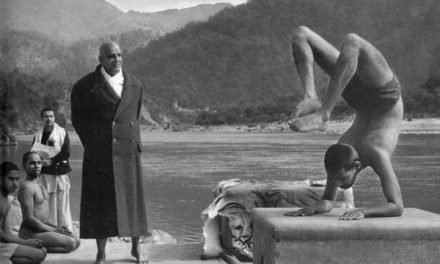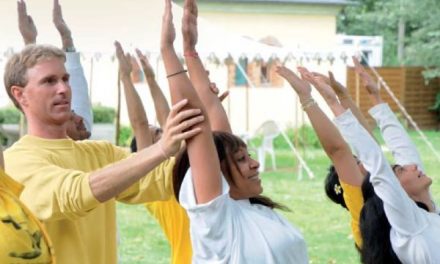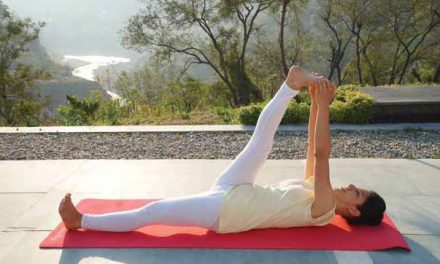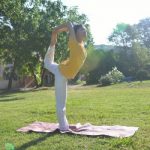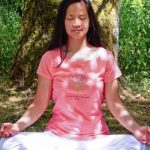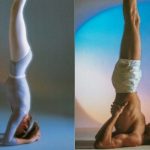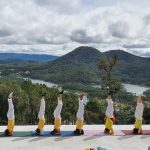 Yoga for a Relaxed Pregnancy
Yoga for a Relaxed Pregnancy
By Ursula Mäder and Hildegard Pätzold
Gentle yoga exercises are a god-given present for all pregnant women. Through the adapted practise of yoga exercises (asanas), the body of a pregnant woman is supported through every stage of pregnancy, gently stretching, easing tension, and adjusting to the moment whilst preparing for the challenge of birth.
Moments of happiness, peace, and calmness are the side effects of the asanas and will transfer to the growing child.
Ursula Mäder (Midwife) and Hildegard Pätzold, both yoga teachers at the Sivananda Yoga Vedanta Centres, with a wealth of experience in teaching yoga to pregnant women, have written the book Yoga for a Relaxed Pregnancy for all women who want to experience the positive benefits of yoga during their pregnancy.
For those women who have been practising the classical sequence of yoga positions for years, it will act as a valuable aid to adapting that practice for pregnancy. This book also serves as a practical reference work for yoga teachers wishing to develop their teaching through the ‘Yoga for Pregnancy’ course. In the following text, you will find some examples from Yoga for a Relaxed Pregnancy.
Pregnancy is a very special time in a woman’s life. While nine months appears to be a long time at first, these months are very precious and pass by all too quickly. This is a period of profound physical change for the mother-to-be. It is also a time in which a woman’s feelings change and she has to redefine her role in her relationship with her partner. A woman who is expecting a child is regarded with interest and curiosity by those around her.
A pregnant woman who decides to practise yoga is choosing a positive environment for herself and her growing child from the outset. Pregnancy is often a time when a woman feels a natural inclination towards introspection and connection with her true self. As such, the breathing exercises are a godsend, as they help calm the constant churning of the mind. Yoga exercises have a wonderful ability to harmonise and bring body, mind, and soul together.
Yoga helps create a protected space for the growing child and a positive, joyful experience for the mother-to-be. Her mind becomes centred, her body remains supple and she has the strength to overcome any obstacles with ease. Women who practice yoga, especially during pregnancy, can learn to tap the source of inner strength and thus better cope with new challenges. The yoga exercises for pregnancy that are found in this book are intended for healthy women.
Every woman, however, has her own personal needs during pregnancy, and these should always be integrated into one’s yoga practice. Therefore, decide for your – self which exercises are best for you. A radiant sense of health after your yoga practice is a sign that you have done the right amount of exercise and performed the positions correctly.
The classical sequence of yoga positions
The classical sequence of yoga positions remains in its original form. For over fifty years these yoga exercises, made popular by Swami Vishnudevananda, have been taught in numerous Sivananda Yoga Vedanta Centres and nine Ashrams worldwide. Over time, these exercises have been adapted to fit the needs of pregnant women.
The sequence of the asanas has been designed in such a way that each position either builds on or provides a counterbalance to the effects of the previous exercise or prepares for the one that follows. In order to experience the energising and balancing effects of the exercises on both the body and mind, it is necessary to practise the exercises and their relevant adaptations and variations in the order prescribed by the classical sequence of yoga practice.
The exercises stimulate all systems of the human body, release muscular tensions and support the skeletal system. The stretching postures massage the internal organs, the endocrine and lymphatic systems, strengthen the heart, and promote good circulation. The digestive and eliminatory systems are also nicely stimulated. In addition, the physical exercises help maintain a good hormonal balance and the breathing exercises calm the nervous system. In the final relaxation, the full effects of the asanas unfold for the body, mind, and soul. The nervous system calms down and the mind comes to rest. Peace and harmony fill your whole being.
Ideal lifestyle during pregnancy
If you want to create the ideal lifestyle during pregnancy, include everything that makes you happy, increases your wellbeing, and avoids, or at least reduces, worries and stress. Pregnant women suffering from constant stress are more likely to have children who will later show signs of behavioural difficulties. Studies show that women with irregular lifestyles and eating habits are more likely to have restless children.
For these reasons, eat regularly and in a quiet place, and make time each day for relaxation and regener ation. Regular exercise, such as swimming, walking, and yoga, will do both you and your baby good. Avoid physical strain and remember the saying “early to bed, early to rise…” – this is good advice for healthy sleep patterns during pregnancy.
In order to provide the best conditions for your growing baby, you should, as a mother-to-be, keep your body free from toxins, eat healthily, and pay attention to your own well-being. Pregnancy offers a great opportunity to give up bad habits. The book contains advice about what you can do during pregnancy to improve your health and that of your baby. This advice is based on the teachings of ancient Indian traditional medicine, Ayurveda, which has attracted increasing attention in recent years due to its holistic approach and impressive results.
Modified Asanas for Pregnancy
All yoga exercises illustrated here can be practiced during the whole pregnancy by healthy pregnant women
The Bridge
and its modified form for pregnant women: The modified Bridge
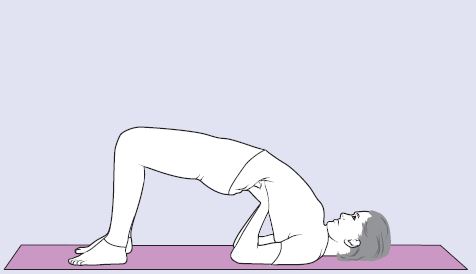
The Bridge
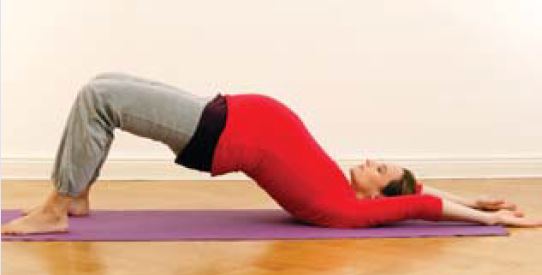
The modified Bridge. In this variation, the posture flows fluently, and is not held as a static pose.
1. Lie on your back with your legs straight. Make sure there is enough room behind you for you to stretch out your arms above your head. Bend your legs and place your feet on the floor, about hip-width apart. Place your arms on the floor alongside your body, palms facing down.
2. On an inhalation, lift your buttocks up and roll your back off the floor while sweeping your arms up over your head until they touch the ground. On the exhalation, roll your spine back down onto the mat and bring the arms back down at the same time, ending with your arms alongside your body again. Repeat the exercise a total of five times.
3. To release the back, bend your knees in-to your chest, place your hands on your knees and rock from side to side, massaging the whole back on the floor.
4. Relax in your chosen relaxation position.
Benefits: Stretches the thighs, massages the shoulders, keeps the back flexible and strengthens the pelvic floor.
The Headstand
and its modified form for pregnant women: The Inverted ‘V’
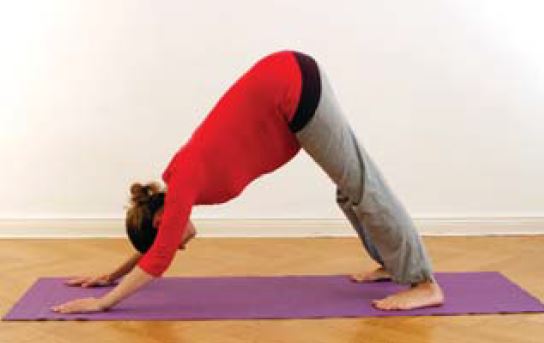
The Inverted ‘V’

The Headstand
1. After a short relaxation in Child’s Pose, come onto all fours.
2. Lift your buttocks upwards and stretch your arms and legs, without moving your feet backwards. Your tailbone should be pointing upwards. The position makes an inverted V shape.
3. Hold the position for three breaths.
Benefits: Inverted positions increase the blood flow to the brain, flushing out the toxins that have collected there and also improving our capacity for thought and concentration. Pressure on the heart is reduced as gravity aids the return of venous blood to the heart. Inversions are a sort of holiday for the internal organs that benefit from this release of pressure and this can ease problems caused by varicose veins. In addition, many nervous and glandular imbalances can be healed, particularly those linked to the reproductive system.
The Locust
and its modified form for pregnant women: The Cat

The Locust

The Cat
1. Come onto all fours with a straight back.
2. Lift your left hand from the floor and stretch the arm out in front of you (hand and arm in line) then stretch the right leg out behind you with the foot flexed. Look towards the floor. Breathe deeply into the abdomen. Hold the position for three breaths and then release slowly.
3. Release the back by moving into the Cat-Cow position a few times. Now repeat the exercise, lifting the left leg and the right arm.
4. Relax in Child’s Pose.
Benefits: This position will be particularly beneficial during mid – to late pregnancy, when the weight of the abdomen places increased pressure on the back and legs. The position also strengthens the back muscles and develops balance.
The Crow
and its modified forms for pregnant women: The Dancer and The Tree

Tree

Dancer

Crow
The Dancer
1 Stand up straight. Bring your weight onto your left foot, bend your right leg behind you and grasp the right ankle with your right hand. Stretch your left hand and arm upwards. Fix a point with your eyes to help you find your balance. Press your upper chest forwards and up and keep your thighs parallel to each other.
2 If you can easily keep your balance in this position, press your right foot backwards, pulling it as far as possible upwards and backwards at the same time with your right hand. This helps stretch the muscles of the hip joint. The left arm remains stretched upwards. Do not bend too far forwards while coming into this position.
3. Hold the position for three breaths and then release slowly. Repeat the exercise on the other side.
The Tree
1. Stand, feet firmly on the floor, feet and legs together. Like a tree, you should feel firmly rooted to the ground.
2. Bend your right leg and place the sole of the foot on the inside of the left thigh, as high up as possible. The right knee should drop out to the side. Fix your gaze on a point in front of you and find your balance. Bring your palms together in front of your chest and slowly raise your hands upwards until the arms are straight. Hold the position for three breaths and then release slowly.
3. Repeat the exercise to the other side, lifting the left leg.
Benefits: The Dancer and the Tree are balancing exercises that focus on stability, inner balance, and grounding. They strengthen our feel for physical balance. If we are sure on our feet, then our whole body can relax. Small imbalances in our posture resolve themselves. There is more space in the chest, shoulders, and throat.
You can find your inner balance. If you are feeling mentally and physically tense and your nerves are on edge, practise this balancing posture – you will notice how the mental and physical imbalances soon lose their power. In addition, this posture strengthens foot and leg muscles.
Yoga for a Relaxed Pregnancy
Ursula Mäder and Hildegard Pätzold have adapted the whole sequence of the classic Sivananda Yoga asanas for pregnant women, which makes it possible to practice yoga with or without experience through the whole pregnancy.
• There is an introduction of two short sequences of asanas if you are short on time.
• There are valuable tips given regarding the yoga and breathing exercises.
• Advice about nutrition to support body and mind during pregnancy are offered in the holistic and gentle way of Ayurveda.
• There is a Pregnancy Yoga Guide for yoga practitioners and yoga teachers.
The book is available from European Sivananda Yoga Centres (see listing on page 72) at a cost of 20 € for the English version and 20,50 € for the German version. It can also be ordered directly from the publisher, Hans-Nietsch-Verlag: www.nietsch.de

